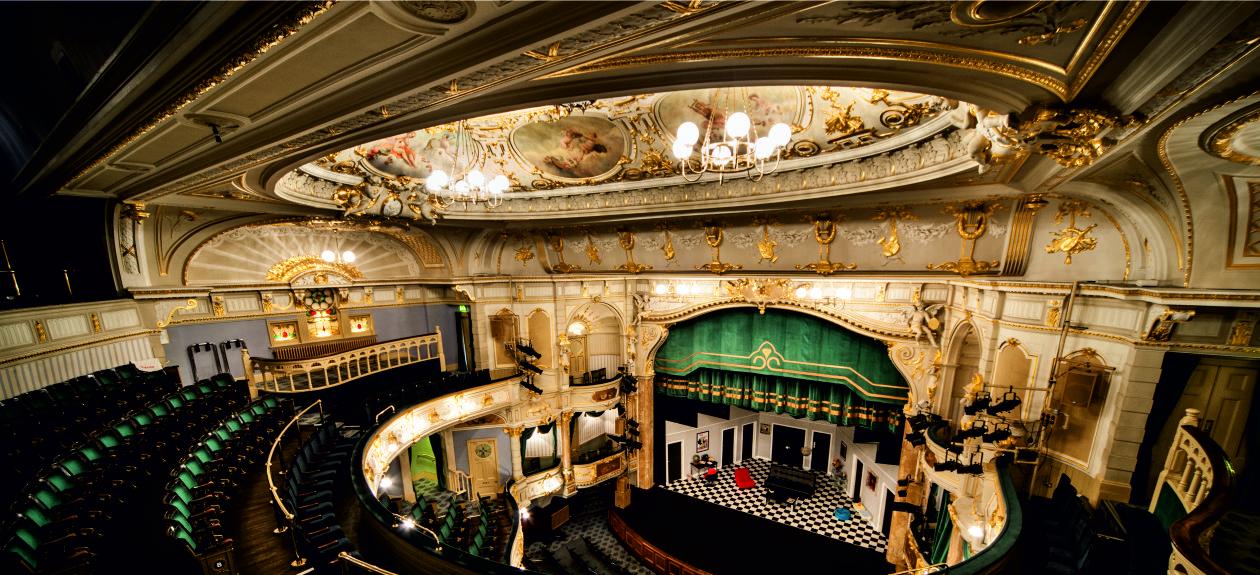
The original plan had the exterior covered in lightweight terra-cotta, but this was changed to stone after the foundations were under construction. This settlement is not because of poor engineering but the fact the design was changed during construction. This deflection is clearly visible in the theater lobby, where the mosaic floor takes on a distinct slope as it nears the outer walls. However, the weight of the masonry outer walls in relation to the relatively lightweight interior deformed the raft during the course of a century, and today portions of the building have settled as much as 29 inches. The resulting raft distributed the weight of the massive outer walls over a large area. Adler and Mueller designed a floating mat of crisscrossed railroad ties, topped with a double layer of steel rails embedded in concrete, the whole assemblage coated with pitch.

The soil beneath the Auditorium consists of soft blue clay to a depth of over 100 feet, which made conventional foundations impossible. One of the most innovative features of the building was its massive raft foundation, designed by Adler in conjunction with engineer Paul Mueller. When completed, it was the tallest building in the city and largest building in the United States. The Auditorium is a heavy, impressive structure externally, and was more striking in its day when buildings of its scale were less common. Richardson's Marshall Field Warehouse, another Chicago landmark. Sullivan and Adler designed a tall structure with load-bearing outer walls, and based the exterior appearance partly on the design of H.H. The interior embellishment, however, is wholly Sullivan's, and some of the details, because of their continuous curvilinear foliate motifs, are among the nearest equivalents to European Art Nouveau architecture.

The rest of the building is a uniform ten stories, organized in the same way as Richardson's Marshall Field Wholesale Store. The entrance to the auditorium is on the south side beneath the tall blocky eighteen-story tower. Fronting on Michigan Avenue, overlooking the lake, was the hotel (now Roosevelt University) while the offices were placed to the west on Wabash Avenue. Hence Adler & Sullivan had to plan a complex multiple-use building. The Auditorium was built for a syndicate of businessmen to house a large civic opera house to provide an economic base it was decided to wrap the auditorium with a hotel and office block. At the time, a young Frank Lloyd Wright was employed at the firm as draftsman, and he may have contributed to the design.

The association hired the renowned architectural firm of Dankmar Adler and Louis Sullivan to design the building. Peck persuaded many Chicago business tycoons to go on board with him, including Marshall Field, Edson Keith, Martin A. The building was to include an office block and a first class hotel. He was said to have wanted to make high culture accessible to the working classes of Chicago. Since 1947, the Auditorium Building has been part of Roosevelt University.įerdinand Peck, a Chicago businessman, incorporated the Chicago Auditorium Association in December 1886 to develop what he wanted to be the world's largest, grandest, most expensive theater that would rival such institutions as the Metropolitan Opera House in New York City. In addition, it is a historic district contributing property for the Chicago Landmark Historic Michigan Boulevard District. It was declared a National Historic Landmark in 1975, and was designated a Chicago Landmark on September 15, 1976. The building was added to the National Register of Historic Places on April 17, 1970. It currently hosts the season performances of the Joffrey Ballet. The theater was the first home of the Chicago Civic Opera and the Chicago Symphony Orchestra. The Auditorium Theatre is part of the Auditorium Building and is located at 50 East Ida B. As a young apprentice, Frank Lloyd Wright worked on some of the interior design. The building was designed to be a multi-use complex, including offices, a theater, and a hotel. Completed in 1889, the building is located at the northwest corner of South Michigan Avenue and Ida B.

The Auditorium Building in Chicago is one of the best-known designs of Louis Sullivan and Dankmar Adler.


 0 kommentar(er)
0 kommentar(er)
